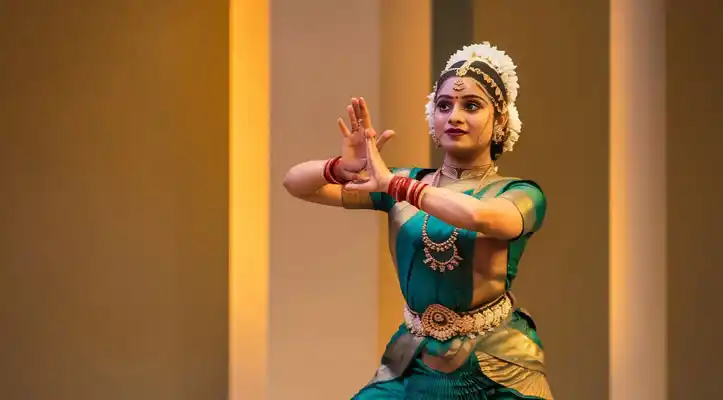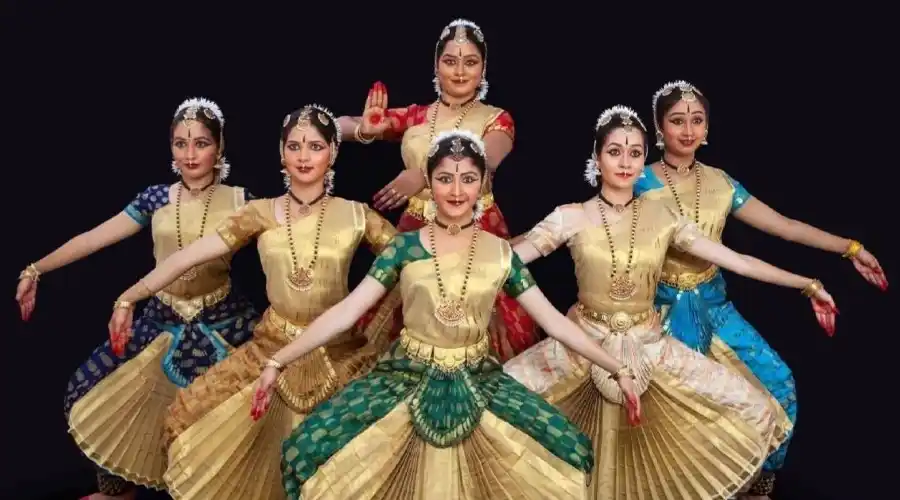Bharatanatyam is one of the most ancient and revered classical dance forms in India, with a history that dates back over 2,000 years. This dance, originating in Tamil Nadu, is a spiritual, cultural, and aesthetic expression rooted deeply in Indian tradition. it is often seen as the embodiment of India’s classical arts, with its combination of rich storytelling, elaborate costumes, and intricate gestures. Let’s explore the origins, techniques, symbolism, and significance of Bharatanatyam in depth.
- The Origins of Bharatanatyam
- Historical Evolution of Bharatanatyam
- Decoding the Name Bharatanatyam
- The Significance of the Name ‘Bharatanatyam’
- The Role of Devadasis and Evolution Through Time
- Key Elements of Bharatanatyam
- Symbolism
- Notable Styles
- The Revival and Globalization
- Bharatanatyam in Modern Times
- The Spiritual and Meditative Aspects
- Conclusion
The Origins of Bharatanatyam
Bharatanatyam traces its roots back to the temples of Tamil Nadu, where it was performed as a sacred offering to the deities. Originally known as Sadhir, it was performed by temple dancers called devadasis, who were considered married to the gods and thus dedicated their lives to dancing as a form of devotion.
This classical dance form is mentioned in ancient texts such as the Natya Shastra, a Sanskrit treatise on performing arts attributed to sage Bharata Muni, written around the 2nd century BCE. Bharatanatyam is known as one of the Pan-Indian classical dance forms, along with Kathak, Kathakali, Odissi, Kuchipudi, and Manipuri. Bharatanatyam is specifically codified with strict guidelines on posture, rhythm, gestures, and expressions that make it unique.

Historical Evolution of Bharatanatyam
Bharatanatyam is believed to have originated over 2,000 years ago in South India, specifically in the temples of Tamil Nadu. Initially known as Sadhir or Dasiattam, it was performed by devadasis, or temple dancers, as part of ritual worship for the deities. The devadasis were highly skilled, well-respected, and dedicated to their art, which was both a form of worship and a sacred duty.
- Ancient Roots in Natya Shastra : Bharatanatyam’s foundation is rooted in the Natya Shastra, an ancient Sanskrit treatise attributed to the sage Bharata Muni, written around 200 BCE. This text, considered the “Bible” of classical Indian dance and drama, laid down the rules for dance, drama, and music, defining movements, expressions, hand gestures, and rhythms that form the backbone of Bharatanatyam.
- Impact of the Colonial Period: During British colonial rule, Bharatanatyam and the devadasi tradition faced severe criticism from Victorian moralists who misunderstood and looked down upon temple dance practices. The dance form was stigmatized and associated with immorality, causing its popularity to decline and the devadasi system to gradually lose state support.
- Revival in the 20th Century: In the early 20th century, Bharatanatyam was revived by several key figures, such as Rukmini Devi Arundale and E. Krishna Iyer, who sought to elevate it as a classical art form rather than mere temple entertainment. Rukmini Devi, in particular, established the Kalakshetra Foundation in Chennai in 1936, redefining Bharatanatyam for the modern stage and helping to protect it as a significant part of India’s cultural legacy.

Decoding the Name Bharatanatyam
The term “Bharatanatyam” itself holds a significant meaning. It is often interpreted as a combination of four essential elements:
- Bhava (Emotion): The expression of feelings and emotions.
- Raga (Melody): The musical aspect that guides the dancer’s mood.
- Tala (Rhythm): The rhythmic pattern that synchronizes with the dancer’s movements.
- Natya (Dance): The dramatic component that conveys stories and ideas through movement and gestures.
This breakdown of the name highlights Bharatanatyam’s comprehensive approach to storytelling, integrating expression, melody, rhythm, and drama in a harmonious flow.
The Significance of the Name ‘Bharatanatyam’
The term “Bharatanatyam” itself holds special meaning. It is often thought to be a combination of “Bhava” (expression), “Raga” (melody), “Tala” (rhythm), and “Natya” (dance), which collectively convey the essence of the dance. This holistic art form combines emotional expression, musical accompaniment, rhythmic timing, and graceful movement. The name itself emphasizes how deeply interconnected these aspects are in creating a dance that is both an aesthetic and spiritual experience.
The Role of Devadasis and Evolution Through Time
For centuries, Bharatanatyam was performed by devadasis, or female dancers who dedicated their lives to the worship and service of Hindu deities in temple settings. The devadasis practiced Bharatanatyam as a form of worship, with the aim of uniting the soul with the divine. The devadasis were highly trained, respected, and provided with land grants by the temples they served.
However, during the colonial era, Bharatanatyam and other temple dances faced severe criticism and suppression, largely due to Victorian morals. The devadasi system fell out of favor, and Bharatanatyam risked extinction until the early 20th century when it was revived by several key figures, including Rukmini Devi Arundale, E. Krishna Iyer, and Balasaraswati. Rukmini Devi played a vital role in taking Bharatanatyam from temple performances to the stage, making it accessible to broader audiences and preserving it as a national treasure.

Key Elements of Bharatanatyam
Bharatanatyam consists of various elements that work together to form a cohesive and expressive performance. Some of the major components are:
- Adavus: Adavus are the basic steps or units of movement in this dance . These steps combine rhythm, posture, and hand gestures to create patterns that serve as the foundation for more complex routines. There are various types of Adavus, such as Tatta, Natta, and Kuditta Mettu, each with unique characteristics.
- Hasta Mudras (Hand Gestures): Mudras play a crucial role in Bharatanatyam, conveying emotions, actions, and symbolic representations. Each hand gesture has a specific meaning, and these are often used in storytelling to express different aspects of the narrative. Some commonly used mudras include Anjali (salutation), Pataka (flag), and Ardhachandra (half-moon).
- Abhinaya: Abhinaya refers to the art of expression in Bharatanatyam, where dancers use facial expressions and body language to convey emotions and tell a story. Abhinaya is divided into four types: Angika (bodily expressions), Vachika (verbal), Aharya (costume and ornamentation), and Satvika (emotions). Through abhinaya, dancers can express a range of feelings such as joy, sorrow, love, and anger.
- Nritta and Nritya: Bharatanatyam is categorized into two types: Nritta and Nritya. Nritta is purely rhythmic dance that does not have any story or meaning but showcases the dancer’s agility and mastery over rhythm. Nritya, on the other hand, involves expressive dance, where the dancer portrays a story, mood, or emotion. Both Nritta and Nritya are essential parts of Bharatanatyam.
- Costume and Makeup: Bharatanatyam costumes are colorful and elaborate, often featuring vibrant silk sarees with pleats that fan out during dance movements. The dancer’s makeup emphasizes the eyes, allowing them to express emotions clearly to the audience. Traditionally, dancers also wear jewelry, including Maang Tikka on the forehead, necklaces, bangles, earrings, and ankle bells, which produce rhythmic sounds as they dance.
- Musical Accompaniment: Bharatanatyam is accompanied by Carnatic music, with instruments such as the mridangam, veena, and flute. Vocalists often sing compositions that tell stories from Hindu mythology. The synergy between music and dance in Bharatanatyam is essential; rhythm and melody guide the dancer’s movements, while the lyrics provide narrative depth.

Symbolism
Bharatanatyam is more than a dance; it is a deeply symbolic art form. The dancer embodies the Nayika (heroine) and interacts with the Nayaka (hero), often symbolized as Lord Krishna or Shiva, representing the divine lover. Many Bharatanatyam performances revolve around themes of devotion, exploring the relationship between the individual soul and the Supreme Being.
The dance is replete with spiritual symbolism. For example:
- The raised hands represent mountains and trees.
- The bent legs symbolize stability and groundedness.
- Movements are often circular, symbolizing the cyclical nature of life and the universe. This depth of symbolism gives Bharatanatyam a timeless quality, as it can be seen as a metaphor for the eternal journey of the soul toward liberation.
Notable Styles
There are various styles or “banis” (traditions) within Bharatanatyam, each associated with a particular lineage of teachers or region in Tamil Nadu. These styles include:
- Kalakshetra Bani: Popularized by Rukmini Devi Arundale, this style emphasizes grace, linear movements, and clean lines. It is known for its aesthetic purity and attention to detail.
- Pandanallur Bani: This style is characterized by large movements, complex postures, and restrained abhinaya, which prioritizes subtlety over exaggerated expression.
- Vazhuvoor Bani: Known for its fluidity and dramatic expressions, this style allows for greater individual expression and often features more elaborate use of abhinaya.
Each style maintains its unique elements while adhering to the core principles of Bharatanatyam, providing dancers with the flexibility to interpret the art in various ways.

The Revival and Globalization
Bharatanatyam gained new life in the 20th century through the efforts of prominent dancers and reformers, who removed the stigma associated with temple dances. Rukmini Devi Arundale played a pivotal role in elevating Bharatanatyam from a temple art to a respected stage performance, bringing it to the attention of the educated middle class and nationalists.
Today, It has achieved international acclaim, with practitioners and admirers worldwide. Schools and institutions in countries like the United States, United Kingdom, Canada, and Australia teach Bharatanatyam, preserving and propagating this ancient art form.
Bharatanatyam in Modern Times
In recent years, it has adapted to include contemporary themes, addressing social issues and experimenting with non-traditional music and movements. Some practitioners have incorporated Western dance elements or fused Bharatanatyam with other classical Indian forms, making it relevant to today’s audiences while retaining its essence.
Bharatanatyam has also found a place in popular culture, with choreographers integrating it into Bollywood and fusion performances. These adaptations, while sometimes controversial, have helped attract younger audiences to Bharatanatyam and ensured its continued relevance in a rapidly evolving world.
The Spiritual and Meditative Aspects
Beyond its performance value, Bharatanatyam is a form of meditation and self-discipline. Dancers often regard it as a path to self-realization, akin to yoga. The intense training and concentration required for Bharatanatyam cultivate focus, resilience, and emotional depth. Many dancers describe a profound sense of connection with the divine while performing, as the boundaries between the dancer and the dance dissolve.
Conclusion
It is remains a dynamic and vital aspect of India’s cultural heritage. With its blend of physical discipline, expressive storytelling, spiritual symbolism, and aesthetic beauty, it is an art form that resonates with audiences around the world. Its survival through centuries, from the temples of Tamil Nadu to the global stage, is a testament to its
enduring appeal and cultural significance. Bharatanatyam, in its timeless grace, continues to celebrate life, love, devotion, and the eternal quest for spiritual union with the divine.
